Renewable energy: Biogas, ENEA presents an innovative, compact, high-yield plant
16/1/2020
Currently running on food scraps from the staff catering facility of the Centro Ricerche Casaccia research centre, the plant is planned also to produce biohydrogen in future and shall be implemented with solar panels.
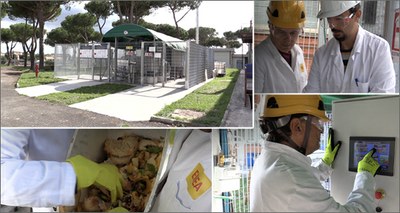 ENEA has built a new experimental plant at the Casaccia research centre in order to produce biogas capable of increasing the yield and methane content by more than 70%, while providing reductions in terms of volumes, times, and production costs compared to “traditional” plants. Like natural gas, biomethane can be used for transport and to produce both heat and electricity. In the near future, the plant is to be expanded and equipped with other components in order to conduct − also in collaboration with the industrial players in this sector − experimentation with (on a pilot scale) a number of decidedly promising technological and process innovations for the production of biomethane and biohydrogen.
ENEA has built a new experimental plant at the Casaccia research centre in order to produce biogas capable of increasing the yield and methane content by more than 70%, while providing reductions in terms of volumes, times, and production costs compared to “traditional” plants. Like natural gas, biomethane can be used for transport and to produce both heat and electricity. In the near future, the plant is to be expanded and equipped with other components in order to conduct − also in collaboration with the industrial players in this sector − experimentation with (on a pilot scale) a number of decidedly promising technological and process innovations for the production of biomethane and biohydrogen.
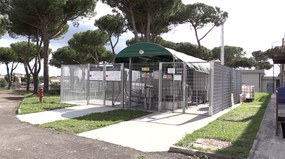 A roof with solar panels is planned, which will shall power the system’s functions and produce a hydrogen current by means of water electrolysis. The hydrogen current shall be used in innovative processes for bioconversion into methane of the CO2 contained in the biogas. The plant consists in a pilot digester of a volume of 1 m3 and an innovative pulsed electric fields device - smaller than those commercially available - which increase the conversion yield into biogas, by accelerating degradation of cellulose, the major component of the biomasses used. Suitable for use with so-called “poor” biomass materials, such as reeds, straw or agricultural or organic waste, it currently runs on food scraps from the centre’s staff catering facility.
A roof with solar panels is planned, which will shall power the system’s functions and produce a hydrogen current by means of water electrolysis. The hydrogen current shall be used in innovative processes for bioconversion into methane of the CO2 contained in the biogas. The plant consists in a pilot digester of a volume of 1 m3 and an innovative pulsed electric fields device - smaller than those commercially available - which increase the conversion yield into biogas, by accelerating degradation of cellulose, the major component of the biomasses used. Suitable for use with so-called “poor” biomass materials, such as reeds, straw or agricultural or organic waste, it currently runs on food scraps from the centre’s staff catering facility.
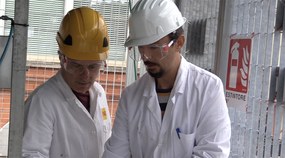 “The production of biogas by means of anaerobic digestion plants is considered a mature technology, use of which is widespread nationwide, and in particular in Northern Italy. However, there are criticalities, especially when a significant percentage of poor biomass is used”, explains Vito Pignatelli, head of the Laboratorio ENEA di “Biomasse e Tecnologie per l’Energia” (biomasses and energy technologies laboratory). In this case, the lower biomass conversion efficiency (approx. 50-60%), and the lower methane content (approx. 50%) raise the costs of any supply of biogas to the grid, for which the legal minimum methane content stands at 97%.
“The production of biogas by means of anaerobic digestion plants is considered a mature technology, use of which is widespread nationwide, and in particular in Northern Italy. However, there are criticalities, especially when a significant percentage of poor biomass is used”, explains Vito Pignatelli, head of the Laboratorio ENEA di “Biomasse e Tecnologie per l’Energia” (biomasses and energy technologies laboratory). In this case, the lower biomass conversion efficiency (approx. 50-60%), and the lower methane content (approx. 50%) raise the costs of any supply of biogas to the grid, for which the legal minimum methane content stands at 97%.
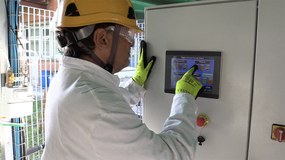 “Thanks to the innovations developed in the ENEA laboratories”, adds Pignatelli, “such as use of selected blends of fungi and bacteria and separation of the various stages of the process of anaerobic digestion using two separate reactors (two-stage), not only can we augment the conversion yields of poor biomasses; we can also prevent production losses. Indeed, should a problem arise for the first reactor, the second reactor can continue to produce methane while we work on the first”.
“Thanks to the innovations developed in the ENEA laboratories”, adds Pignatelli, “such as use of selected blends of fungi and bacteria and separation of the various stages of the process of anaerobic digestion using two separate reactors (two-stage), not only can we augment the conversion yields of poor biomasses; we can also prevent production losses. Indeed, should a problem arise for the first reactor, the second reactor can continue to produce methane while we work on the first”.
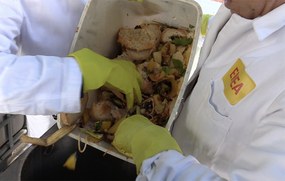 “An important innovative element compared to other research infrastructures in Italy is the high degree of flexibility, enabling verification on a pilot scale of the efficacy of various options and configurations for the process, applied separately or combined, testing technological solutions that can be offered to the marketplace for enhancement and greater efficiency of existing plants.
“An important innovative element compared to other research infrastructures in Italy is the high degree of flexibility, enabling verification on a pilot scale of the efficacy of various options and configurations for the process, applied separately or combined, testing technological solutions that can be offered to the marketplace for enhancement and greater efficiency of existing plants.
“However, there are other more general benefits: by using food scraps we work toward curbing waste and, with the use of poor biomass, we are able to economically exploit agricultural waste that remains largely unused. There is also the prospect of recovering land that has deteriorated or that cannot be used for conventional agricultural production purposes, such as areas in the vicinity of landfills”, concludes Pignatelli.
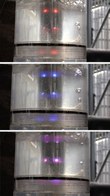 The entire biogas production process in the experimental plant is also managed by a control system run by dedicated software that enables programming of operations, and “ongoing” gauging of the volume and composition of the biogas produced, and of key process parameters (temperature, pH and levels). The experimental apparatus, created within the ambit of the Programma Industria 2015 (Industry Program 2015) , financed by the Ministry of Economic Development, in collaboration with the company Ladurner Ambiente (project leader), is part of the multi-year research and technological development and demonstration activities of ENEA aimed at increasing overall efficiency of the anaerobic digestion process through infrastructures, benchtop fermenters, small circuits and experimental plants, as well as pilot plants (themselves with a volume of a number of cubic meters).
The entire biogas production process in the experimental plant is also managed by a control system run by dedicated software that enables programming of operations, and “ongoing” gauging of the volume and composition of the biogas produced, and of key process parameters (temperature, pH and levels). The experimental apparatus, created within the ambit of the Programma Industria 2015 (Industry Program 2015) , financed by the Ministry of Economic Development, in collaboration with the company Ladurner Ambiente (project leader), is part of the multi-year research and technological development and demonstration activities of ENEA aimed at increasing overall efficiency of the anaerobic digestion process through infrastructures, benchtop fermenters, small circuits and experimental plants, as well as pilot plants (themselves with a volume of a number of cubic meters).
For further information:
Vito Pignatelli, manager of ENEA - Laboratorio Biomasse e Tecnologie per l’Energia: vito.pignatelli@enea.it;
Roberto Ciccoli - ENEA, Biomass and Energy Technologies Laboratory: roberto.ciccoli@enea.it
